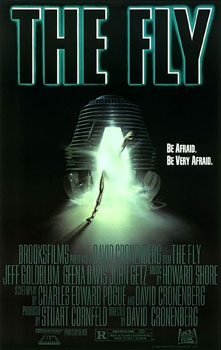
The Fly is a 1986 American science fiction horror film directed and co-written by David Cronenberg. Produced by Brooksfilms and distributed by 20th Century Fox, the film stars Jeff Goldblum, Geena Davis and John Getz. Loosely based on George Langelaan's 1957 short story of the same name and the 1958 film of the same name, The Fly tells of an eccentric scientist who, after one of his experiments goes wrong, slowly turns into a fly-hybrid creature. The score was composed by Howard Shore and the make-up effects were created by Chris Walas, along with makeup artist Stephan Dupuis.

The Fly is a 1958 American science fiction horror film and the first installment in The Fly film series. The film was produced and directed by Kurt Neumann and stars David Hedison, Patricia Owens, Vincent Price, and Herbert Marshall. The screenplay by James Clavell is based on the 1957 short story of the same name by George Langelaan.

The Fly II is a 1989 American science fiction horror film directed by Chris Walas. The film stars Eric Stoltz and Daphne Zuniga, and is a sequel to the 1986 film The Fly, itself a remake of the 1958 film of the same title. Stoltz's character in this sequel is the adult son of Veronica Quaife and Seth Brundle, a scientist who became a human-fly hybrid as a result of an experiment gone awry, played by Jeff Goldblum in the 1986 remake. With the exception of footage of Goldblum from the first film, John Getz was the only actor to reprise his role, with another actress filling the Geena Davis role as Quaife in the opening birth scene. Unlike the previous film, this film received negative reviews.

Creature is a 1985 American science fiction horror film directed by William Malone, starring Stan Ivar, Wendy Schaal, Lyman Ward, Annette McCarthy, Robert Jaffe, Diane Salinger, and Klaus Kinski. It features early special effects work by Robert and Dennis Skotak, who would go on to design the special effects for Aliens.
Kong: The Animated Series is an animated television series that follows King Kong, the title character based on the 1933 film of the same name. The series was a co-production between BKN International, Ellipse Animation and M6, and premiered in France on the latter network on May 2, 2001.
George Langelaan was a French-British writer and journalist born in Paris, France.

Curse of the Fly is a 1965 American horror science-fiction film and a sequel to Return of the Fly (1959), as the third installment in The Fly film series. It was released in 1965, and unlike the other films in the series was produced in the United Kingdom. The film was directed by Don Sharp and the screenplay was written by Harry Spalding.

Return of the Fly is a 1959 American horror science-fiction film and sequel to The Fly (1958). It is the second installment in The Fly film series. It was released in 1959 as a double feature with The Alligator People. It was directed by Edward Bernds. Unlike the previous film, Return of the Fly was shot in black and white.

Transylvania 6-5000 (1963) is a Warner Bros. Merrie Melodies animated short directed by Chuck Jones. The short was released on November 30, 1963, and stars Bugs Bunny. It was the last original Bugs Bunny short Jones made for Warner Bros. Cartoons before Jones left for Metro-Goldwyn-Mayer to found his own studio, Sib Tower 12 Productions. It was his second-to-last cartoon at Warner Bros. before moving to MGM, and the second-to-last Warner cartoon in 1963.
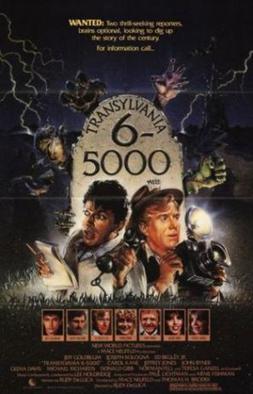
Transylvania 6-5000 is a 1985 American/Yugoslav horror comedy film about two tabloid reporters who travel to modern-day Transylvania to uncover the truth behind Frankenstein sightings. Along the way, they encounter other horror film staples — a mummy, a werewolf, a vampire — each with a twist.
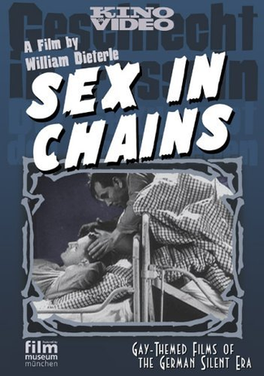
Sex in Chains is a 1928 silent film directed by William Dieterle.
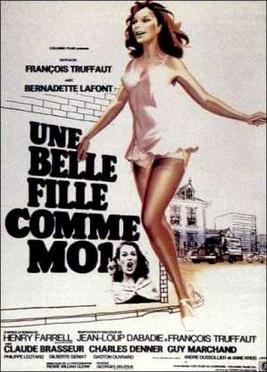
A Gorgeous Girl Like Me, also known as A Gorgeous Bird Like Me, is a 1972 French film directed by François Truffaut, starring Bernadette Lafont. It is based on Henry Farrell's 1967 novel of the same name.

Le Bouchera.k.a.The Butcher is a 1970 French psychological thriller film written and directed by Claude Chabrol and starring Stéphane Audran and Jean Yanne. Set in the village of Trémolat, it tells the story of butcher Popaul who falls in love with Hélène, the head teacher of the school, while a murder spree is taking place in the area.

Tell No One is a 2006 French thriller film directed by Guillaume Canet and based on the 2001 novel of the same name by Harlan Coben. Written by Canet and Philippe Lefebvre and starring François Cluzet, the film won four categories at the 2007 César Awards in France: Best Director, Best Actor, Best Editing and Best Music Written for a Film.

Muriel is a 1963 French psychological drama film directed by Alain Resnais, and starring Delphine Seyrig, Jean-Pierre Kérien, Jean-Baptiste Thiérrée, and Nita Klein. Its plot follows a middle-aged widow in Boulogne-sur-Mer and her stepson—recently returned from military service in the Algerian War—who are visited by her ex-lover and his new young girlfriend.

Patricia Molly Owens was a Canadian-born American actress, working in Hollywood. She appeared in about 40 films and 10 television episodes in a career lasting from 1943 to 1968.
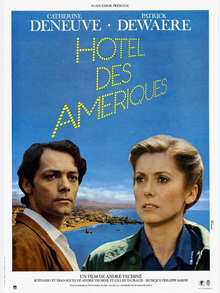
Hotel America is a 1981 French romantic drama film directed by André Téchiné, starring Catherine Deneuve and Patrick Dewaere. The film, set in Biarritz, tells the ill-fated romance of mismatched lovers. This is the first of several collaborations between Téchiné and Deneuve, who became his favorite actress.

In Case of Adversity is a 1958 French crime film directed by Claude Autant-Lara and starring Jean Gabin, Brigitte Bardot and Edwige Feuillère. It was released as Love Is My Profession in the United States. It tells the story of a married lawyer who rigs a trial to acquit a young female criminal he has become obsessed with, even to the point of imagining they might have a life together and start a family. The screenplay was written by Jean Aurenche and Pierre Bost after the novel In Case of Emergency by Georges Simenon. The film was released in France on 17 September 1958.

The film series of The Fly is a sequence of science fiction-horror films, consisting of an original series started in 1958 and a remake series made in the 1980s. The first film of the series, The Fly, was produced and distributed by 20th Century Fox in 1958 as a colour film. The two following black and white sequels, Return of the Fly and Curse of the Fly, both produced by Associated Producers, were released in 1959 and 1965 respectively. The original film was remade in 1986, The Fly directed by David Cronenberg. The remake film received the Academy Award for Best Makeup in 1987. Its sequel, The Fly II, was released in 1989. All five films within the series were distributed by 20th Century Fox.
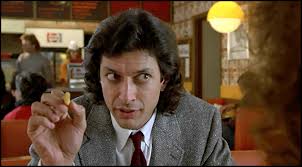
Dr. Seth Brundle, also known as Brundlefly, is a fictional character and the tragic hero in David Cronenberg's 1986 remake of The Fly. He is played by Jeff Goldblum. Brundle was the third of Goldblum's "nerdy scientist" roles and is one of his most famous roles to date.
















